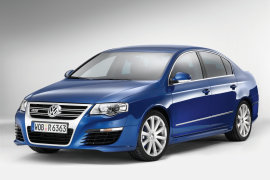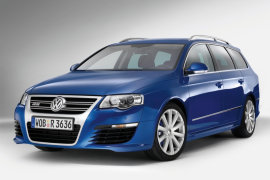VOLKSWAGEN Passat R Models/Series Timeline, Specifications & Photos
First production year: 2008
Engines: Gasoline
In 2008, Volkswagen decided to give a performance boost for its mid-size sedan, the Passat. The car was well known in Europe, but mostly for its fuel-efficient TDI engine.
The change from the fifth to the sixth generation of the Passat was big. That generation was considered one of the best vehicles ever made by Volkswagen. It also featured a powerful version such as the W8 that offered 271 hp. Considering this, the German car-maker installed a new top-model on the sixth generation of the Passat: the R36.
Its look was not so much different than the rest of its lineup. Some details were telling that that was not the regular, economic vehicle. Upfront, there was a massive silver grille instead of the body-colored one on the rest of the Passat's range. Bigger air-scoops were installed on the modified front bumper and special 18” light-alloy-wheels were fitted as standard. The bi-xenon headlights and the LED taillights were standard as well.
Inside, there was an abundance of carbon-fiber decals on the dashboard, instrument cluster, and center console. The aluminum pedals were part of the pack. The front bucket-seats were highly bolstered for supplementary side support during high-speed cornering. But, most importantly, the 3.6-liter engine offered more power than the previous W8 Passat, even if it had a smaller displacement and two cylinders less. In fact, it was the most powerful Passat ever built by Volkswagen.
Known mostly by its fuel-efficient versions, the Passat was one of the most common choices in the European mid-size segment, but in 2008 also came with the R36 sporty version, available as a sedan or station wagon.
Families who needed a larger vehicle could always opt for a station wagon, but fast drivers needed more powerful engines and transmissions on which they could rely on. Volkswagen already knew that since its premium brother Audi already made big money with the RS4/RS6 Avant models. Considering this, the Wolfsburg-based carmaker dropped a potent engine under the Passat's hood, and thus the R36 was born.
You didn't have to be a champion at a "find the differences" game to recognize an R36 from a mundane TDI version of the Passat. First of all, there was a completely different front bumper extended downwards and included a broad center grille flanked by two air-intakes to cool the brakes. Moreover, the ground clearance was lowered, and a pair of aerodynamically-profiled skirts adorned the sides of the vehicle. Last but not least, the back of the car received a wider roof spoiler than the rest of its Varian siblings, and a dual exhaust system flanked the rear apron.
Inside, Volkswagen added a pair of sport bucket seats with R36 logos embroidered on the front seats' seatbacks. Moreover, the steering wheel was decorated with the same badge on the lower of the three spokes it featured, while the pedals were finished with a stainless steel aspect. Finally, on the center console, the gear selector for the automatic transmission had an aluminum look.
But all those visual modifications were meant to complete the drivetrain. Volkswagen installed a 3.6-liter V6 under the hood that developed 295 hp (300 PS) and a healthy dose of torque. It was mated to a six-speed automatic gearbox (DSG) that sent the power in all corners via a Haldex electronically controlled system.

